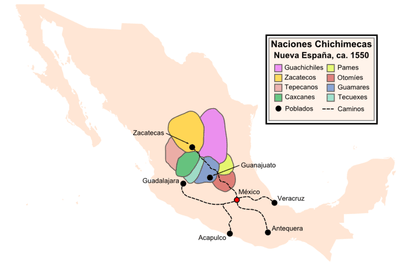Guachichil
The Guachichil, Cuauchichil, or Quauhchichitl, are an Indigenous people of Mexico. Pre-contact, they occupied the most extensive territory of all the indigenous Chichimeca Nations tribes in pre-Columbian Central Mexico.
 Map of Chichimeca Nations Guachichile territory in purple. | |
| Total population | |
|---|---|
| Unknown | |
| Regions with significant populations | |
| Central Mexico (e.g. Zacatecas, Guanajuato, San Luis Potosí) | |
| Languages | |
| Guachichil, Spanish | |
| Religion | |
| Roman Catholic | |
| Related ethnic groups | |
| Other Chichimecas |
The Guachichiles roamed through a large region of Zacatecas; as well as portions of San Luis Potosí, Guanajuato, and northeastern Jalisco; south to the northern corners of Michoacán; and north to Saltillo in Coahuila.
History
Considered both warlike and brave, the Guachichiles played a major role in provoking the other Chichimeca tribes to resist the Spanish settlement. The historian Philip Wayne Powell wrote:[1][2]
- " Their strategic position in relation to Spanish mines and highways, made them especially effective in raiding and in escape from Spanish reprisal."
These warriors were known to fight fiercely even if mortally wounded and were a key component in the Spanish defeat during the Chichimeca Wars. The children learned to use the bow at walking age and the hunters were such good shots that if they missed the eye and hit the eyebrow they would be extremely disappointed. The Chichimeca bow and arrow was expertly crafted allowing for penetration of Spanish armor.
Two Spanish accounts of the Chichimeca's archery skill: "On one occasion I saw them throw an orange into the air, and they shot into it so many arrows that, having held it in the air for much time, it finally fell in minute pieces” (Powell 48). “One of don Alonso de Castilla’s soldiers had an arrow pass through the head of his horse, including a crownpiece of double buckskin and metal, and into his chest, so he fell with the horse dead on the ground ‘this was seen by many who are still living’ (Powell 48).
The Chichimeca were nomadic making them very mobile and experts of the rough vegetation filled (mostly cactus) land in which they always looked for hiding spots. “His long use of the food native to the Gran Chichimeca gave him far greater mobility than the sedentary invader, who was tied to domesticated livestock, agriculture, and imported supplies. The nomad could and did cut off these supplies, destroy the livestock, and thus paralyze the economic and military vitality of the invaders; this was seldom possible in reverse” (Powell 44). They attacked in small groups ranging from five up to two-hundred braves. They highly valued animal furs and highly treasured European scalps. The most valued of those being red hair due to their cultural importance of the color red. The Chichimeca were easily willing to trade seized gold and silver for red haired women as noted by an extremely small percentage of the population in that territory today having brownish-reddish hair, more noticeably when mixed with whites of non-red haired origin. Red haired women and children were a large incentive used to obtain peace within the region.
- War Tactics
The Guachichil would outsmart/deceive their adversaries instead of relying on brute force. “He sent spies into Spanish-Indian towns for appraisal of the enemy’s plans and strength; he developed a far-flung system of lookouts and scouts (atalays); and, in major attacks, settlements were softened by preliminary and apparently systematic killing and stealing of horses and other livestock, this being an attempt, sometimes successful, to change his intended victim from horseman to foot soldier” (Powell 46). When they attacked they used a very good tactic that terrified the animals and scared the Spanish. The Guachichil would disguise themselves as grotesque animals using animal heads and red paint then yelled like crazed beasts making the Spanish lose control of the livestock. The fifty mile mountain range, from currently La Montesa to Milagros, Zacatecas, was known as "El Camino Del Infierno" or "The Path of Hell" by the Spanish. The caravans were required to pass through that fifty mile mountain range because a detour would be very lengthy. Within "The Path of Hell" the most ferocious attacks took place. Ancient Guachichil murals of the region paint the indigenous accounts of these events.
- Origin of name
The Guachichiles were known to paint their bodies, hair, and faces in red dye. For this reason they were called "guachichile" by the Mexica; from the nahuatl kua-itl (head) and chichil-tic (red), meaning "heads painted red".
Language
| Cuachichil | |
|---|---|
| Region | Zacatecas |
| Extinct | (date missing) |
unclassified (Corachol?) | |
| Language codes | |
| ISO 639-3 | None (mis) |
0w6 | |
| Glottolog | None |
The Guachichil language is now extinct and very little is known about it. It may have been an Uto-Aztecan language closely related to the Huichol language.[3]
See also
- Indigenous peoples in Mexico
- Pre-Columbian cultures of Mexico
References
- Houstonculture.org: Guanajuato
- Latinola.com: Guachichiles
- Miller, Wick. (1983). Uto-Aztecan languages. In W. C. Sturtevant (Ed.), Handbook of North American Indians (Vol. 10, pp. 113–124). Washington, D.C.: Smithsonian Institution.
Hernandez, Manuel G. “Cartas de Indias: Publicalas Por Primera Vez” Ministerio De Formento 1877. 326-340. Madrid. Print.
Powell, Philip Wayne. “Soldiers, Indians & silver; the northward advance of New Spain, 1550-1600.” Berkeley: University of California Press, 1952. Print
Santa Maria, Guillermo de. “Guerra de los Chichimecas : Mexico 1575 – Zirosto 1580” Paleography by Carrillo Cazares, Alberto. 2nd Ed. University of Guadalajara, Michoacan College, University of Norte, University Los Lagos, 220. San Luis College 2003. Print.